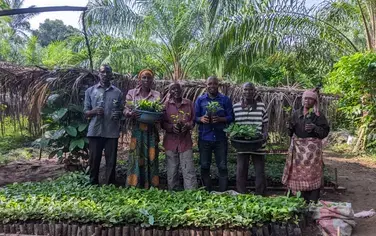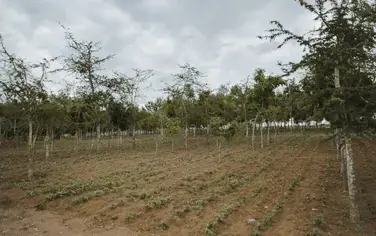This post originally appeared on Landscape News (GLF) here.
NAIROBI (Landscape News) – Delegates attending the Global Landscapes Forum (GLF) conference at UN Environment headquarters in Nairobi backed a proposal to seek support from the U.N. General Assembly for a U.N. Decade of Ecosystem Restoration 2021-2030.
The move came a day after Erik Solheim, head of UN Environment, urged support for the decade, which would put landscape restoration at the forefront of national agendas, backing country level efforts to meet U.N. Sustainable Development Goals, including SDG 15, Life on Land.
After plenary discussions concluded, Solheim appointed Ghanaian born Afro roots musician and humanitarian activist Rocky Dawuni a Goodwill Ambassador.
“He’s a great, great singer and, added to that, he has a big passion for the environment,” Solheim said. “You’re a great singer with a big heart for the environment so please excite people into environmental action.”
In his acceptance remarks, Dawuni said he wanted lead the crowd of about 800 audience members into battle for the environment.
“It’s a moral responsibility for all of us,” he said. “We’re supposed to live in harmony with nature, but tonight we celebrate, tonight we evolve a new concept, tonight we spread our voices far and wide for everybody to know that we can be members of this human family and stand also for the Earth.”
After Dawuni’s appointment, Kenyan UN Environment Goodwill Ambassador Suzanna Owiyo performed a musical set as an overture to a follow-up concert by Duwani, which served as a grand finale.
The evening of celebrations concluded the two-day GLF conference, which attracted around 800 delegates to UN Environment headquarters and 24,000 people online.
GROWING SUPPORT
The U.N. Decade of Ecosystem Restoration initiative is now supported by the eight country members of the Central American Commission for Development and Environment (CCAD) under the Central American Integration System (SICA). During an AFR100 (the African Forest Landscape Restoration Initiative) side event, a member of the Uganda delegation said the country would support the decade.
Speaking at the closing plenary, CCAD Executive Secretary Salvador Nieto summed up the motivations behind the proposal: “Ecosystem restoration is now high in the international agenda; it is bolstered by both legally binding and voluntary agreements, and countries in Central America have gained valuable experience while developing national plans for restoration.”
“We believe a U.N. Decade of Ecosystem Restoration will allow the international community to mobilize resources for restoration; monitor progress internationally; and advance recognition of restoration as a means to advance the U.N. Sustainable Development Goals,” said Nieto.
Supporters say the initiative would not only advance SDG 15, but would help achieve SDG 2 (Zero Hunger), SDG 6 (Clean Water and Sanitation), SDG 12 (Responsible Consumption and Production), SDG 13 (Climate Action) and SDG 14 (Life Below Water).
El Salvador is urging the international community to endorse and take forward its proposal to the U.N. General Assembly in New York in September, so Nieto called on African governments to join the cause.
“Yesterday I talked to ministers from African countries and I hope their support to the proposal will be reflected at the U.N. General Assembly,” he said. The assembly opens next on Sept. 18 in New York.
The GLF convened ministers and other high-ranking officials from countries such as Ethiopia, Rwanda and Zambia in addition to Kenya.
“We have talked about rights, tenure, gender, finance and policy, and we have also heard the voices of the youth and conducted lots of networking,” summed up Robert Nasi, director general of the Center for International Forestry Research (CIFOR).
TARGETED INTERVENTIONS
During the event, Nasi noted the importance of making the best use of available resources by deciding “where, why and for whom to restore.”
Restoration is about reversing damage done to landscapes and, ideally, bringing them back to a pre-degradation state. And this goes beyond forests: in Africa, for example, rangelands make up around 40 percent of the land that needs to be restored.
“Unfortunately, we cannot always restore the initial ecosystem,” said Nasi. As a result, success will look different depending on the starting point and the purpose of the restoration, he said. “Understanding what we mean by landscape restoration is important because we have limited resources and we must do a triage.”
FINDING FUNDS
A main challenge is how to attract financing to forest restoration to close the $300 billion annual funding gap. For Nasi, the business case is compelling.
Every year, $6.3 trillion of ecosystem service value is lost to landscape degradation, while restoring 350 million hectares by 2030 as part of agreed commitments under the Bonn Challenge would generate a net benefit of up to $9 trillion.
“There are between seven and 30 in economic benefits for every dollar invested in restoration” Nasi said, urging a paradigm change to embrace this practice for the sake of both people and the planet. Blending public and private finance and attracting private capital are two of the alternatives he put forward.
At a discussion forum on value chains, director general of the World Agroforestry Centre (ICRAF) Tony Simons also touched on the issue of financing. “Governments own up to 80 percent of the forests in Africa, and the pressure to convert them to other land uses is always there,” he noted.
“Our jobs is to de-risk investment in landscape restoration to bring in private sector investment,” said Simons. He pointed out that, for every dollar of external Overseas Development Assistance (ODA), there’s $3 of remittances, $6 of Foreign Direct Investment (FDI), $24 of domestic private sector spend, $55 of national government spend and $1,000 of private capital.
Panelists at the finance plenary highlighted the need to generate bankable projects; de-risk initiatives in the land use sector, and blend public and private finance.
Ladé Araba, Africa Region representative of Convergence Finance made two recommendations to project developer: “think about how to monetize the economic value of landscapes and think about revenue models that will allow you to achieve that, such as selling carbon credits or developing ecotourism. Figure out how to leverage these assets to generate cash flow, and then you will be able to attract investment.”
Satya Tripathi, senior adviser for the 2030 Agenda for Sustainable Development at UN Environment said: “Investment in blended finance as a way of financing programs that change livelihoods and landscapes for the better.”
POLICIES AND GENDER
Participants at the GLF also noted the need to harmonize policies as part of a landscape approach to land management, and to deal with tensions around use of land and resources.
“What if you restore a forest but someone else reaps the benefits?” queried Munhamo Chisvo, chief executive and head of mission at FARNPAN. “A big policy issue is who should fund the public good and get the private benefit.”
Panelists pointed out stark differences in the ways women and men experience the landscapes and are impacted by the health of landscapes.
“We need to engage both women and men in landscape restoration efforts, from project design to monitoring and benefit-sharing,” said REFACOF president Cécile Ndjebet. “We must also understand that, in any given landscape, they have different roles and expectations, so they must both be represented.”
Nigel Sizer, chief program officer at the Rainforest Alliance, explained that men’s farming plots in Africa are more productive than women’s because of differential access to inputs and a bias in the extension services.
Sizer also noted women face a much higher risk of being displaced because they are not landowners. “We have to do much more to support women’s organizations, so they can better advocate for themselves,” he said.
Kenya is the homeland of Wangari Maathai, the Nobel Peace laureate that rallied thousands of fellow Kenyans — particularly women — around her Green Belt Movement. “One way to promote peace is to promote sustainable management and equitable distribution of resources,” she used to say.



